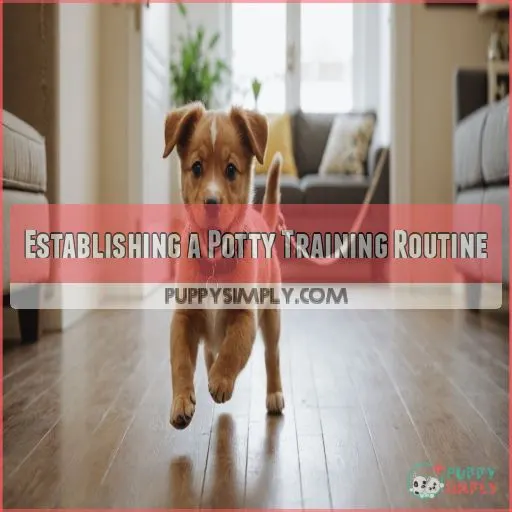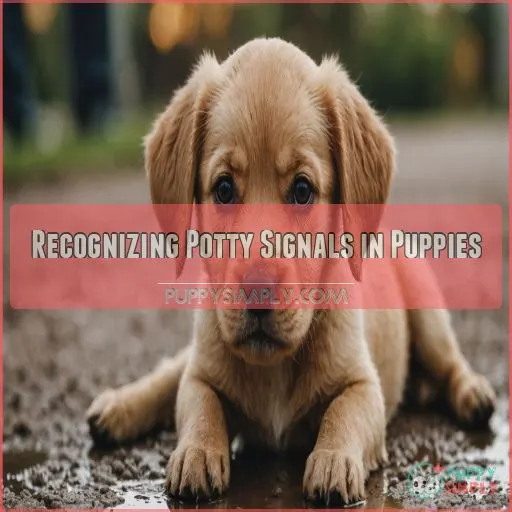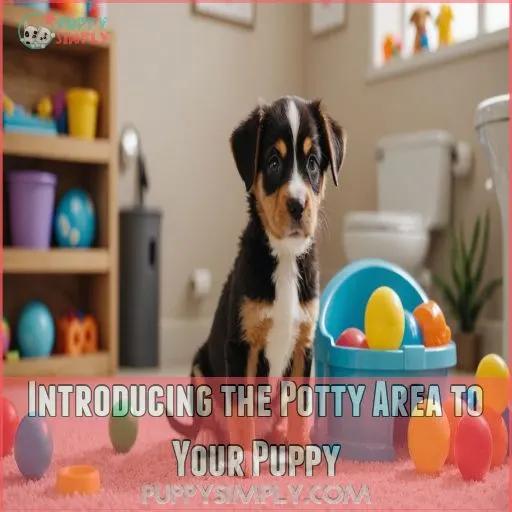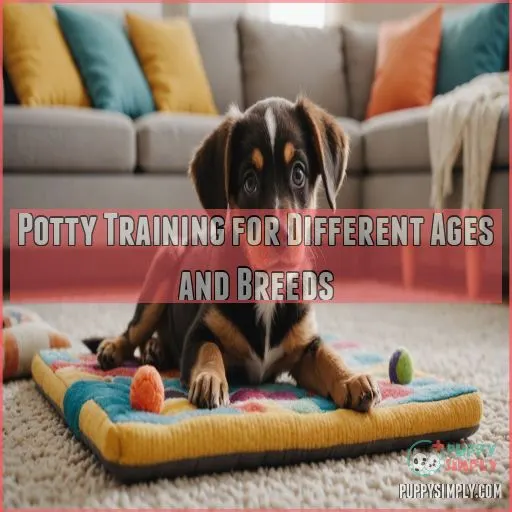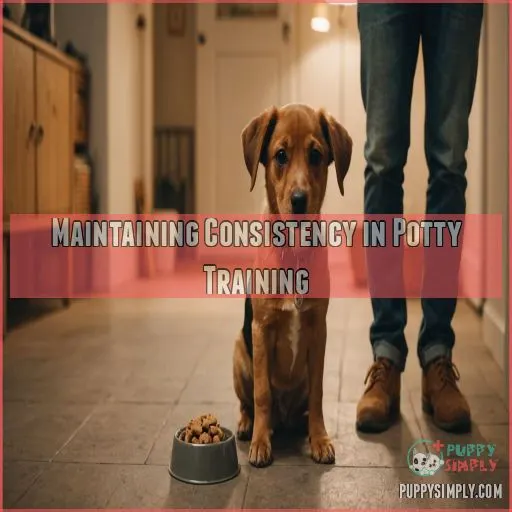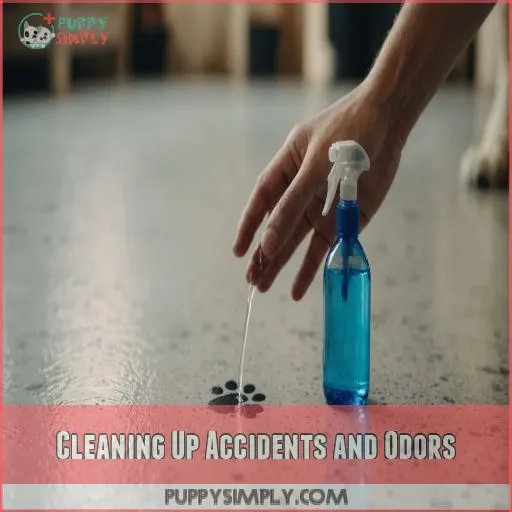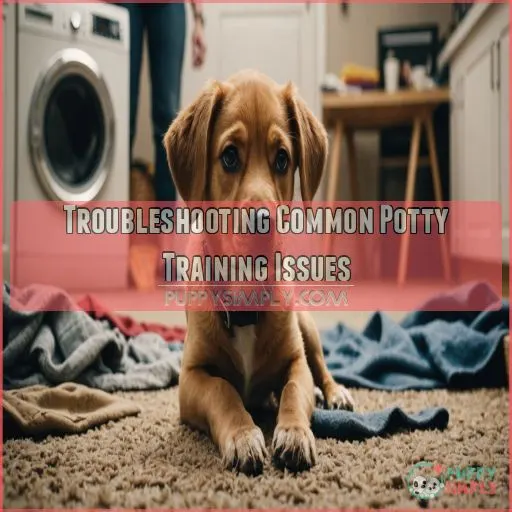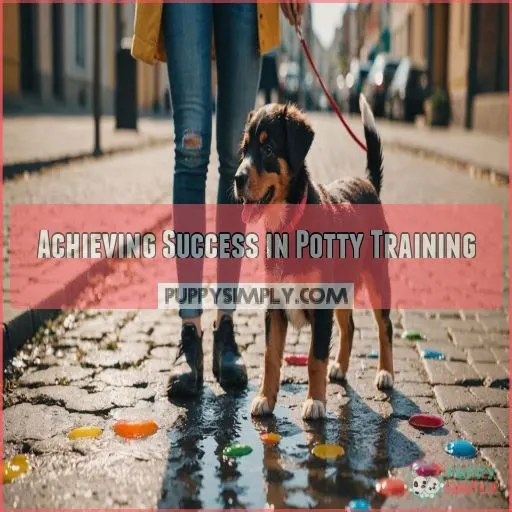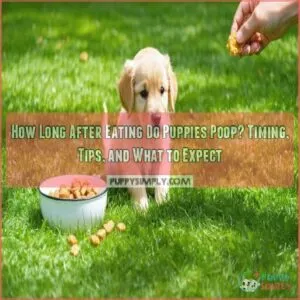This site is supported by our readers. We may earn a commission, at no cost to you, if you purchase through links.
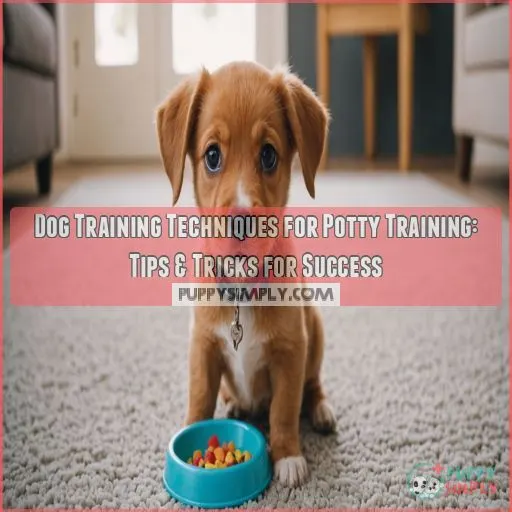 Potty training your dog is like teaching a toddler to use the toilet—it requires patience, consistency, and lots of reinforcement!
Potty training your dog is like teaching a toddler to use the toilet—it requires patience, consistency, and lots of reinforcement!
Start by establishing a routine that aligns feeding and potty breaks.
Watch for signals like sniffing or circling, which often mean it’s time to go.
Use positive reinforcement, showering your pup with treats and praise when they get it right.
Crate training can help because dogs naturally avoid soiling their sleeping area.
Remember, accidents happen.
Clean them quickly to prevent future mishaps.
Stick to the plan, and soon you’ll have a potty-trained pup ready to conquer the world!
Need more tips? Read on!
Table Of Contents
- Key Takeaways
- Establishing a Potty Training Routine
- Recognizing Potty Signals in Puppies
- Introducing the Potty Area to Your Puppy
- Potty Training Techniques for Puppies
- Overcoming Common Potty Training Challenges
- Potty Training for Different Ages and Breeds
- Maintaining Consistency in Potty Training
- Cleaning Up Accidents and Odors
- Troubleshooting Common Potty Training Issues
- Achieving Success in Potty Training
- Frequently Asked Questions (FAQs)
- How to potty train a puppy?
- Can a 3 year old child be potty trained?
- How do you teach a dog to go potty?
- How difficult is potty training a dog?
- How do you stop a dog from peeing and pooping in the house?
- How to successfully potty train a dog?
- How do you train a dog from peeing and pooping in the house?
- How do you discipline a dog for potty training?
- How to address nighttime potty accidents?
- What should I do if my puppy regresses in potty training?
- How to handle potty training during travel?
- What are the best potty training tools for apartment living?
- How to train a puppy to signal when needing to go out?
- Conclusion
Key Takeaways
- Keep your cool, even when accidents happen. Puppies are like toddlers: adorable, unpredictable, and often messy. Clean up quickly with enzyme cleaners to erase scents and prevent future slip-ups on your floors.
- Consistency’s your secret weapon! Establish a routine that combines feeding schedules with potty breaks. Think of it as a two-step dance—same moves, every time, until your pup’s a potty pro.
- Celebrate success! When your puppy nails it on the potty spot, let them know they’re the star of the show. Praise, treats, and belly rubs are the Oscars of dog training, so hand them out generously.
- crate training can be a lifesaver. Dogs don’t like to mess where they snooze, so a comfy crate helps them hold it in. Just ensure it’s snug and cozy—Goldilocks would approve.
Establishing a Potty Training Routine
Potty training your puppy doesn’t have to be a mess if you create a solid routine that combines consistent feeding schedules with timely potty breaks for Shih Tzus.
Pick a potty spot your puppy can call their "office," and always have treats handy to praise them like they’ve just discovered buried treasure!
Creating a Schedule for Feeding and Potty Breaks
To kickstart puppy potty training, create a consistent schedule for feeding and potty breaks.
Puppies thrive on routine, so align meal times with potty breaks.
Make sure:
- Regular intervals based on puppy age factors
- Consistent timing
- Frequent and rewarding trips
Choosing a Designated Potty Spot
Choosing the right potty spot is key.
Pick an outdoor area in your yard that’s quiet and away from high-traffic zones.
This consistent location will help your pup associate that spot with their potty needs.
Avoid indoor potty pads if possible, as they can confuse your puppy.
Using Positive Reinforcement Techniques
Positive reinforcement is your secret sauce for potty training success!
Shower your pup with treats, praise, and rewards when they get it right.
- Clicker train.
- Use consistent cues.
- Celebrate wins.
- Be patient.
Preparing Necessary Supplies
A well-prepared toolbox is a dog owner’s best friend.
Grab essentials like a sturdy leash, mouthwatering treats, and enzyme cleaner.
Add a comfy crate and handy potty pads to master dog care.
You’re ready for successful potty training adventures!
Recognizing Potty Signals in Puppies
In your puppy’s world, sniffing, circling, and pacing aren’t just fun dog games—they’re important potty signals.
Understanding these cues can save your rug while keeping your furry friend happy (and your sanity intact)!
Identifying Sniffing and Circling Behaviors
Your puppy’s sniffing and circling behaviors are telltale signs they need to go potty.
Watch for these cues:
- Intense, focused sniffing around the floor or corners
- Tight, repetitive circling in one spot
- Sniffing and circling that increases in frequency and duration
- These signals indicate it’s time to quickly take your pup outside!
Recognizing Squatting and Lifting Leg Signals
While keeping your eyes peeled for potty signals, notice when your puppy squats or lifts a leg.
This body language is like flashing neon lights saying, "I need to go!"
Recognizing these cues can turn you into a dog training expert.
Responding to Whining and Barking Cues
After recognizing squatting signals, it’s time to respond to whining and barking cues.
Don’t ignore these puppy pleas!
Whining versus barking indicates different needs, so distinguish wisely.
Consistency matters in dog training techniques.
Use positive reinforcement to strengthen potty habits.
Understanding Restlessness and Pacing
Just heard your pup whining?
Now, keep an eye out for restlessness or pacing, like a furry toddler on too much sugar.
These signals often mean potty time.
Grab that leash and enzyme cleaner, and let your dog training techniques shine!
Introducing the Potty Area to Your Puppy
When introducing your puppy to their potty area, consistency is key—lead them to the designated spot like it’s their new favorite bathroom hangout.
Use a cheerful phrase to signal potty time, and soon your puppy will be excited to "go" outside and enjoy those well-earned rewards!
Leading Your Puppy to the Designated Potty Spot
Leading your puppy to the designated potty spot is a bit like uncovering the buried treasure of leash training success.
Start with a cheerful stroll to the potty area in your yard, where familiar scents entice them to do their business.
Using a Consistent Phrase to Signal Potty Time
You’ve got your puppy at the potty spot, now say a consistent phrase like "Go potty!" each time.
It helps them connect command training with action, bridging dog communication gaps.
Remember, repetition is key; dogs are creatures of habit!
Rewarding and Praising Successful Potty Breaks
When your pup successfully goes potty in the right spot, shower them with enthusiastic praise, a tasty treat, or their favorite toy.
This positive reinforcement will encourage the behavior and make potty training a breeze.
- Treats
- Praise
- Consistency
Establishing a Routine for Potty Breaks
Building on praise, establish a routine for potty breaks to match feeding schedules. Timing’s everything! Think of it like a dance—consistent steps lead to success. Remember, puppies are just babies; they’ll need breaks more than teenagers at a concert.
Accident Prevention
| Puppy Age | Crate Timing | Accident Prevention | Feeding Schedule | Reward System |
|---|---|---|---|---|
| 8 Weeks | 2-3 Hours | Frequent Breaks | 4x Daily | Treats |
| 3 Months | 3-4 Hours | Outdoor Walks | 3x Daily | Praise |
| 6 Months | 4-5 Hours | Regular Monitoring | 2x Daily | Playtime |
| 9 Months | 5-6 Hours | Routine Inspections | 2x Daily | Belly Rubs |
| 1 Year | 6-8 Hours | Daily Consistency | 2x Daily | Chew Toys |
Potty Training Techniques for Puppies
When potty training your puppy, some tried-and-true techniques can make the process less of a chore and more of an adventure.
By mastering crate and leash training, supervising outdoor bathroom breaks, and keeping calm during accidents, you’ll soon have a pup that’s house-trained and proud!
Crate Training for Potty Training
Introducing your puppy to a potty spot sets the stage for crate training.
Crate training is helpful because:
- Dogs won’t soil where they sleep.
- Proper crate size is important.
- Manage crate anxiety with toys.
- Limit crate duration responsibly.
Leash Training for Potty Breaks
Leash-training your puppy during potty breaks helps them focus on the task at hand, preventing distractions and playtime.
Keeping them on a leash makes sure you can guide them directly to their designated toilet spot every time.
This consistency is key for successful potty training.
Supervising Your Puppy During Potty Breaks
While leading your pup to the potty spot is key, keeping an eagle eye during indoor playtime is equally important.
Supervise closely; puppies are like toddlers—easily distracted!
Avoid accidents by adding crate time, ensuring their focus remains steadfast on your routine.
Handling Accidents and Setbacks
Don’t cry over spilled milk or puppy accidents! They’re part of the potty training journey. Consistency and patience are key.
- Clean with enzyme cleaners to prevent re-marking.
- Revisit the routine after setbacks.
- Reward successes with positive reinforcement.
Overcoming Common Potty Training Challenges
Potty training your puppy can sometimes feel like solving a mystery, especially when accidents happen, or progress stalls.
Don’t worry!
With patience and a few clever tricks, you’ll tackle these challenges like a pro, turning setbacks into stepping stones for success.
Addressing Accidents in the House
Accidents happen, but don’t sweat it!
Quickly clean up messes with an enzyme cleaner to remove odors and prevent re-soiling.
Reward your pup when they go in the right spot to reinforce good behavior.
Stay positive – accidents are part of the process.
Managing Potty Training Regression
Regression’s a bump in the road. Keep heart and manage it by:
- Identifying cause: age, routine changes?
- Consistency’s key: stick to the schedule.
- Minimize distractions during potty time.
- Handle setbacks gently, celebrate wins.
Stay positive; paws-itively achievable!
Dealing With Potty Training Resistance
Puppy stubbornness can feel like herding cats.
Stay calm and remember, consistency matters.
Use positive reinforcement to reward good behavior.
Crate training tips are handy too.
Patience is key; a little love and laughter will conquer resistance.
Keep wagging!
Preventing Nighttime Potty Accidents
Tackling nighttime potty accidents is like figuring out a maze in the dark.
Crate training tips, like those found in crate training for sleep success, can help your puppy sleep through the night accident-free.
Stick to a consistent puppy sleep schedule, restrict water before bed, and choose the right bedding.
Potty Training for Different Ages and Breeds
Potty training looks a little different for puppies of all ages and breeds.
Whether you have a tiny teacup pup or a giant breed, our expert tips will help you navigate the unique challenges and find the perfect potty training approach for your furry friend.
Potty Training for Young Puppies (8-12 Weeks)
In those early weeks, use these steps to become a pro at understanding your puppy:
- Create a consistent potty schedule.
- Implement crate training for success.
- Recognize puppy signals, preventing accidents.
- Leash training helps focus during potty breaks.
Potty Training for Older Puppies (3-6 Months)
Older puppies are adorable but sometimes stubborn!
Stick to a routine, maintaining consistency with crate training and responding swiftly to signals.
| Schedule | Action | Reward |
|---|---|---|
| Morning: 7 AM | Walk, potty time | Small treat |
| Noon: 12 PM | Play, potty time | Praise |
| Evening: 8 PM | Relax, potty time | Favorite toy |
Control chaos with a smile!
Potty Training for Small and Large Breeds
Potty training requires considering your puppy’s breed-specific challenges.
Large breeds might need bigger crates, while small dogs can benefit from smaller spaces.
Keep these tips handy:
- Choose a properly sized crate.
- Use potty pads sparingly.
- Address accidents at night.
Potty Training for Puppies With Special Needs
Raising a puppy with special needs? Don’t fret – with a little extra TLC, you can conquer potty training.
Work closely with your vet, use specialized aids, and shower your pup with patience and praise.
You’ve got this!
Maintaining Consistency in Potty Training
Keeping everyone in your home singing from the same potty training hymn sheet can make all the difference in your puppy’s success.
Sticking to a routine with consistency and positivity mightn’t make you the favorite house member at first, but your carpets will thank you!
Ensuring All Family Members Are on the Same Page
Imagine a family team building with your puppy!
When everyone’s on the same page, consistent commands create harmony.
Communication is key—think of it as a group chat focused on potty success.
With teamwork, you’ll outsmart accidents and foster a well-trained pup!
Sticking to a Routine and Schedule
Keeping a consistent routine is like having a secret weapon in your potty training arsenal.
It eases your puppy’s worries and brings predictability into their world.
Stick to a steady potty schedule alongside feeding times, sleep patterns, and crate time.
Avoiding Punishment and Negative Reinforcement
Avoid punishing your pup for accidents – it’ll only make them afraid and less likely to learn.
Stay upbeat and patient instead.
Accidents happen, so clean up calmly and take them straight to their potty spot.
Consistency is key for successful potty training.
Rewarding Good Behavior and Progress
Wave goodbye to punishments and say hello to treats! Rewarding your pup’s potty success with praise or their favorite game teaches them consistency.
Positive reinforcement is like the cherry on top of the sundae—everyone wants more of that sweet goodness.
Cleaning Up Accidents and Odors
Cleaning up accidents is a messy but essential part of potty training your puppy, and thankfully, there are ways to make it easier.
Enzyme cleaners that tackle stubborn odors, combined with a touch of patience, will turn potential disasters into minor hiccups as you stay on track to potty training success!
Using Enzyme Cleaners to Remove Odors
Ah, the joys of puppy parenthood! When accidents happen, using enzyme cleaners can save the day, shooing away odors like a scarecrow in a cornfield.
To tackle those pesky smells, try these steps:
- Choose pet-safe enzyme cleaner types.
- Follow DIY cleaner recipes.
- Use effective odor prevention techniques.
- Trust enzyme cleaners for foolproof results.
Removing Stains and Disinfecting Surfaces
When accidents happen, reach for enzyme cleaners to tackle stubborn stains and odors.
These pet-safe products break down organic matter, eliminating lingering smells.
Disinfect surfaces with a gentle, non-toxic cleaner to prevent bacteria growth and discourage your pup from re-soiling the area.
A little elbow grease goes a long way!
Preventing Re-Marking and Re-Soiling
You’ve tackled the stains, but stopping re-marking is the cherry on top.
Use enzyme cleaners to nix those lingering smells—dogs can sniff out past mistakes better than Sherlock Holmes.
If repeat accidents occur, rethink scent removal tactics.
Remember, dogs don’t mean to peeve you; they’re just following their noses!
Troubleshooting Common Potty Training Issues
Even the best-laid potty training plans can hit a snag, but don’t worry, it’s fixable!
Sometimes your pup’s "puddles" are a cry for help and might mean a vet visit is needed or you need to tweak your approach—after all, even dog trainers need a little help once in a while.
Addressing Medical Issues Affecting Potty Training
Sometimes potty training goes awry due to medical issues like urinary tract infections or intestinal parasites.
To keep your pup on track, consider checking with a vet.
Watch for:
- Urinary infections
- Digestive issues
- Medication side effects
Identifying and Addressing Training Gaps
Oops, have you noticed your pup’s potty training regressing?
Don’t fret – it’s common for puppies to hit speed bumps.
Pinpoint where the training fell short and get back on track with consistent, positive reinforcement.
You’ve got this!
Managing Environmental Factors Affecting Potty Training
Weather’s a funny thing—rain can turn your yard into a puppy Slip ‘n Slide! Here’s how to navigate environmental hiccups:
- Home distractions: Minimize noisy gadgets.
- Dog park safety: Avoid crowded times.
- Travel tips: Stick to routines.
Seeking Professional Help When Needed
If your puppy’s potty training hits a plateau, don’t fret!
Seeking professional guidance from a trainer or vet can be a game-changer.
They’ll offer expert advice on behavior issues, helping you navigate the wild world of potty training challenges.
Achieving Success in Potty Training
Achieving success in potty training your puppy is all about setting realistic goals and celebrating each little victory along the way.
Remember, patience and positivity are your best friends, so keep up the encouragement, and your pooch will be a potty pro in no time!
Setting Realistic Expectations and Goals
Setting realistic expectations is key to potty training success.
Puppies learn at their own pace, so be patient and celebrate small wins along the way.
Aim for gradual progress, not overnight perfection – your pup will get there with time and consistency.
Celebrating Progress and Milestones
Every little success in potty training is worth a celebration!
Don’t hesitate to throw a mini-party with treats, praise, and positive encouragement.
Rewarding your puppy reinforces good behavior, building confidence and understanding as they learn where to go potty.
Maintaining a Positive and Patient Attitude
Just like celebrating progress and milestones, maintaining a positive and patient attitude is key in potty training.
Remember these steps:
- Don’t sweat puppy mistakes.
- Patience rewards you and your puppy.
- Use positive reinforcement.
- Keep consistent training efforts.
Continuing Training and Reinforcement
Isn’t it rewarding to see progress?
Celebrate each potty success with treats and praise!
Consistency‘s your secret weapon.
Keep those schedules tight, your routine is golden.
Don’t worry about slip-ups; patience is key.
You’ve got this—every pawprint closer to triumph!
Frequently Asked Questions (FAQs)
How to potty train a puppy?
Tired of puppy puddles on your floor?
Start potty training by establishing a routine with a designated potty spot.
Use positive reinforcement and consistent phrases.
Accidents happen, so be patient.
Remember, Rome wasn’t built in a day!
Can a 3 year old child be potty trained?
With patience, consistency, and the right techniques, you can potty train a 3-year-old child.
Start by establishing a routine, using positive reinforcement, and being attentive to their cues.
You’ve got this!
How do you teach a dog to go potty?
Worried about accidents? Start by choosing a potty spot and establish a routine.
Recognize their signals, like circling or sniffing, then leash up and head out.
Reward success with treats, keeping it all consistent and positive!
How difficult is potty training a dog?
Potty training your pup isn’t a piece of cake, but with consistency, patience, and a heap of positive reinforcement, you’ll soon have a house-trained dog.
Expect a few hiccups, but it’s a rewarding journey.
How do you stop a dog from peeing and pooping in the house?
First, be the detective and watch for the "pee dance" — sniffs and circles.
Take your dog outside immediately and reward success.
Keep a routine, use positive reinforcement, and clean accidents with enzyme cleaner to prevent repeats.
How to successfully potty train a dog?
You’ve got this! Start by establishing a consistent routine, rewarding good behavior, and staying patient.
With time and consistency, your pup will be a potty-training pro in no time.
Just remember – accidents happen, so don’t get discouraged.
How do you train a dog from peeing and pooping in the house?
Picture your home as a canvas, and your puppy’s mind as a sponge.
Establish routines, use positive reinforcement, and recognize signs to guide them outside.
Patience is key—mistakes happen, but with consistency, you’ll create a masterpiece.
How do you discipline a dog for potty training?
Don’t punish your dog for potty accidents.
Instead, focus on positive reinforcement.
When your pup goes outside, shower them with praise and treats.
Remember, patience is key—train with love, and they’ll catch on eventually!
How to address nighttime potty accidents?
Tackle nighttime potty accidents by limiting water intake before bed and taking your dog out right before bedtime.
Create a cozy den with a perfectly sized crate, ensuring it’s just snug enough to discourage accidents.
What should I do if my puppy regresses in potty training?
If your pup takes a step back in potty training, don’t fret – it’s all part of the journey.
Revisit the basics and shower them with praise when they get it right.
You’ve got this, champ!
How to handle potty training during travel?
Traveling with your puppy? Stick to your like glue! Bring that trusty leash, treats, and enzyme cleaner.
Scout a potty spot at each stop, and use your familiar cue phrase to keep ’em on track.
What are the best potty training tools for apartment living?
Living in an apartment, you’ll find potty pads, a reliable enzyme cleaner, and a portable indoor dog potty are your best friends.
Patience is key—your pup might have accidents, but every day’s a stepping stone!
How to train a puppy to signal when needing to go out?
Teach your puppy to ring a bell when nature calls by hanging the bell on the door they use.
Each time they go out, tap their paw on the bell.
They’ll catch on faster than you’d think!
Conclusion
Admittedly, potty training a pup can feel like a tough task.
But with the right dog training techniques, patience, and consistency, you’ll have your furry friend mastering the art of the potty in no time!
Remember, every dog’s journey is unique, so celebrate even the smallest victories along the way.
Soon, you’ll be enjoying a well-trained, house-trained dog who’s ready to conquer the world – or at least your backyard.
Stick with it, and you’ll be a dog training pro in no time!

